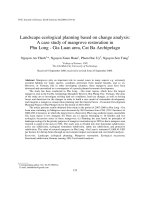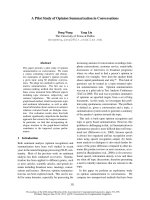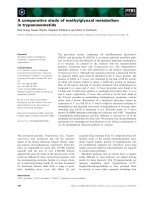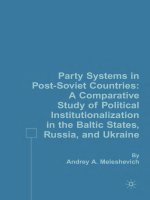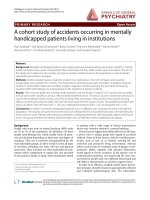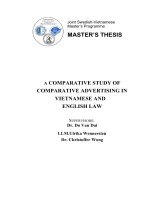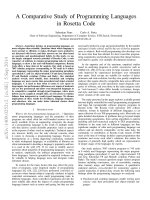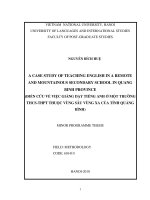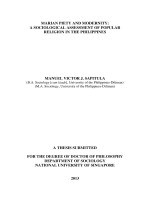Credit to capabilities a sociological study of microcredit groups in india
Bạn đang xem bản rút gọn của tài liệu. Xem và tải ngay bản đầy đủ của tài liệu tại đây (1.68 MB, 336 trang )
Credit to Capabilities
A Sociological Study of Microcredit Groups in India
Credit to Capabilities focuses on the controversial topic of microcredit’s
impact on women’s empowerment and, especially, on the neglected
question of how microcredit transforms women’s agency. Based on
interviews with hundreds of economically and socially vulnerable
women from peasant households, this book highlights the role of the
associational mechanism – forming women into groups that are embedded in a vast network and providing the opportunity for face-to-face
participation in group meetings – in improving women’s capabilities. It
also reveals the role of microcredit groups in fostering women’s social
capital, particularly their capacity for organizing collective action for
obtaining public goods and for protecting women’s welfare. It argues
that, in the Indian context, microcredit groups are becoming increasingly
important in rural civil societies. Throughout, the book maintains an
analytical distinction between married women in male-headed households and women in female-headed households in discussing the potentials and the limitations of microcredit’s social and economic impacts.
Paromita Sanyal is an assistant professor of sociology at Cornell
University. Her research interests include development, gender, economic sociology, and participatory forms of governance like deliberative
democracy (gram sabha in India).
Credit to Capabilities
A Sociological Study of Microcredit
Groups in India
PAROMITA SANYAL
Cornell University
32 Avenue of the Americas, New York, ny 10013-2473, usa
Cambridge University Press is part of the University of Cambridge.
It furthers the University’s mission by disseminating knowledge in the pursuit of
education, learning, and research at the highest international levels of excellence.
www.cambridge.org
Information on this title: www.cambridge.org/9781107077676
© Cambridge University Press 2014
This publication is in copyright. Subject to statutory exception
and to the provisions of relevant collective licensing agreements,
no reproduction of any part may take place without the written
permission of Cambridge University Press.
First published 2014
Printed in the United Kingdom by Clays, St Ives plc
A catalog record for this publication is available from the British Library.
Library of Congress Cataloging in Publication Data
Sanyal, Paromita.
Credit to capabilities : a sociological study of microcredit groups in India / Paromita
Sanyal.
pages cm
Includes bibliographical references and index.
isbn 978-1-107-07767-6 (alk. paper : hbk)
1. Microfinance – Social aspects – India. 2. Entrepreneurship – India.
3. Poor women – Employment – India. 4. Self-employed women –
India. 5. Businesswomen – India. 6. Women – India – Economic
conditions. 7. Women – India – Social conditions. I. Title.
hg178.33.i4s366 2014
332–dc23
2014037191
isbn 978-1-107-07767-6 Hardback
Cambridge University Press has no responsibility for the persistence or accuracy of
urls for external or third-party Internet Web sites referred to in this publication
and does not guarantee that any content on such Web sites is, or will remain,
accurate or appropriate.
Contents
Acknowledgments
page vii
Introduction
1. The global trajectory of microcredit
The savior–slayer dichotomy
Deploying social relationships for financial ends
Contradictions and controversies
Extrapolating from the evidence from West Bengal
2. Agency
Existing approaches
Social deprivation in a context of patriarchy and control
An appositional approach
Gender “habitus”
Strategies of observing agency
Pathways to agency
3. Converting loans into leverage
Wives who turned worthy
Brides who bargained
Mired mutinies
Conclusions
4. The power of participation
Self-conscious social awareness
Social interaction
Physical mobility
Domestic power
Civic participation
Conclusions
1
9
16
20
22
30
36
38
43
45
52
55
58
61
65
80
85
91
93
98
106
110
114
120
127
v
vi
Contents
5. Microcredit and collective action
Collective action and sanctioning
Explaining the capacity for collective action
128
131
154
6. Culture and microcredit: why socio-religious
dimensions matter
“Group styles” in microcredit
In search of explanations
Conclusions
163
167
185
197
7. Loans and well-being
Egalitarian Muslim households
De facto female-headed Muslim households
True female-headed Muslim households
Egalitarian Hindu households
De facto female-headed Hindu households
True female-headed Hindu households
Conclusions
202
204
209
212
219
223
229
234
8. Interpreting microcredit
Looking beyond the salvation–exploitation dichotomy
9. Epilogue: the future of microcredit
Methodological debates and directions
Microcredit’s place in policy
Philanthropy, free market, and choices facing microcredit
235
235
252
253
261
265
Appendix
Bibliography
282
311
Index
322
Acknowledgments
One summer (now several years back) I arrived in Kolkata (India), with a
plan of researching microcredit groups, driven by the desire to bring a
sociological perspective to bear on the study of these groups. The people
who helped in the initial days by putting me in touch with the key NGOs
were Manab Sen and Tarun Debnath. Without their introduction I might
not have gained as ready access to the field. The two NGO leaders, who
I shall not name (to preserve their organizations’ anonymity), graciously
allowed me access to the microcredit groups under their implementation
and allowed me the use of their organization’s residential facilities during
the period of my research. The group supervisors took me around to the
groups, accommodating this task of showing me around in the initial days
within their busy schedules. And, foremost, the women whom I interviewed indulged my many questions, for the most part patiently, taking a
break from their hectic daily schedules and juggling their competing
demands at home and in their agricultural fields. Without their willingness
to talk to me, this project would not have come to fruition. I am full of
gratitude toward them, and I hope to return to the NGOs to share this
book with the organizations.
In the U.S. the development of this book was aided by comments from
and conversations with Marty Whyte, Mary Brinton, Peggy Levitt, Patrick
Heller, Raka Ray, and Vijayendra Rao. My colleagues at Cornell
University have been great cheerleaders. I would like to particularly
thank Richard Swedberg and my ex-colleague Steve Morgan. I have
given innumerable talks on this research in the U.S. and all of those
opportunities have helped me crystallize my thoughts on this topic and
helped me publicize my research. For this I would like to thank all the
vii
viii
Acknowledgments
people who have invited me out to present this research – Lyn Spillman at
University of Notre Dame; Monica Prasad at Northwestern University;
Patrick Heller at Brown University; Vijayendra Rao at The World Bank;
Jeannie Annan at the International Rescue Committee; Elora Chowdhury
at UMass., Boston, among others.
My family and friends have sustained me through this long period. My
parents Bikash and Jharna Sanyal deserve special mention for their academic encouragement and support. My husband has been a source of
constant inspiration and strength. Their love and dedication to my work
are pillars on which the book stands. For this I am indebted to them, and
some debts can never be repaid.
Introduction
Mumtaz Begum led me to her house through a short, winding path to
wait for the other group members to arrive. She appeared to be in her
early to mid-thirties and resembled the village women I had glimpsed
on my way to this rural hamlet, except for one feature that set her apart.
She did not have the end of her saree draped over her head in a ghomta,1
a comportment that is meant to denote the lajja, or modesty, that
married women are supposed to embody. It was about eleven o’clock
during the day, and most of the working-age males were out in their
fields or plying their trades elsewhere. I entered her house – a one-room
structure made of bamboo, straw, and packed mud with a terracottatiled roof – and settled down on a hand-stitched jute mat that she had
spread on the floor for me. Noticing that there was no one else in her
household, I asked casually where her other family members were. This
question, an innocent conversation-starter, made her pause ever so
slightly. Then she crouched down beside me and started talking in a
hushed tone:
I have a shotin.2 He married again for having children. There’s a lot of history.
I told him repeatedly when I married him, that I couldn’t have children. He said it
was not a problem, that it would be OK. I made him promise that he wouldn’t
take another wife later for having children. He agreed. But such is my fate. See,
I was a Hindu girl from Naihati, a proper town not a village like this one here, and
1
2
Words in Bangla, or the Bengali language, which appear in this book have been italicized
throughout and explained in the text or in accompanying footnotes.
This term denotes the relationship between the co-wives of a man in a polygamous
relationship.
1
2
Introduction
I was married once before. But it was against my will. My father was very ill,
nearly dying. He was worried that he would leave behind an unmarried daughter.
So, after seeing some interested parties, he and my elder brother arranged my
marriage. But I was against it. I was only fourteen at the time, studying in class
eight. And the man they had chosen was much older than I. He was a widower.
I think he paid my father and brother to fix the match. The marriage went
through, and I was with him for several years. I even had two sons. But I hated
being with him.
Then, one day, as I was passing through the village center, I saw him (the man
that would become her next husband). This was a nearby village to which I had
moved after my marriage. He was a tailor, and he worked in the ready-made
garment shop in this village. We both noticed each other. From then on, we started
seeing each other whenever we had a chance. But we were careful not to let anyone
know. After some time of this going on, he said he wanted to marry me. He had not
been married yet. I told him about my situation. And I told him that I’d had the
operation after having two children, and that’s why I wouldn’t be able to bear
children in the future. If he married me, he would have to remain childless. At the
time, he said it would be fine. So one day, as we had planned, I left that man and the
children and came away with him.
We got married soon after. That’s when I got this name and became a Muslim.
For quite a few years we were happy; there weren’t any problems. Then gradually
he became interested in having a child. This was the beginning of tensions.
I reminded him of his promise to me. But, finally, he decided to take a second
wife. I couldn’t do anything to stop him. This time he married into his own
community. After the first year or so, they had their first child. And just a few
months back she had a second child. That’s why she’s at her father’s house now.
At that time, I made a deal with him. I told him that since he had broken his
promise, from that time on, I was going to be “free.”3 I wasn’t going take on any
of the household responsibilities, and I would have the liberty to do as I wished.
He agreed.
During these years, I had learnt tailoring from him. It was through my own
“idea” though. I used to ask him to teach me how to use the sewing machine. He
would tell me to learn handling the machine first. The rest, he said, I would learn on
my own with time. I thought that rather than depend on him to teach me, I would
try it out on my own. I kept trying and was finally able to do it. Now I can cut and
sew ready-made garments on my own. These past eight to ten years I’ve been doing
tailoring jobs. We have cultivation on our land, but most of it is given away on
lease. We’ve retained only a portion of it and employ hired labor for cultivating it,
since neither of us knows anything about farming. Both of us work on the sewing
machine. The other one (second wife) does all the housework. I don’t do any
housework. I keep myself busy with my own work and, other than that, I am
completely “free.” I can go anywhere I want.
3
This word was mentioned in English in the original speech. Throughout the text I have
specified similar direct English usage by the women by delineating these words with an
additional quotation mark.
Introduction
3
Three years ago, when microcredit groups started forming in our village,
Firdausi (the leader of her group) told me, “You’re ‘free’. You should get
involved in this work. If you become the leader, then it will be convenient for
me, because then both of us will be able to do this work together.” I told her that
I was too caught up and wouldn’t be able to manage it. At that time, I was already
working [as an unskilled caregiver] at a nursing home for three or four months.
This was a few months after his second marriage. I was desperate to get out of the
house. I have a relative who lives in the next village. One day she told me,
“You’re facing such difficulties in your life. I think, if you involve yourself in
some work, you’ll be able to live more independently.” So she introduced me to
the nursing home people. But they had a completely Muslim list.4 Although they
had accepted my employment there, some still had objections. They would make
me do all kinds of work, but they wouldn’t pay me. And I can’t ask anyone for
something; this is a problem I have. I wasn’t able to say anything. So, I returned
home on the day of Eid and never went back. I had worked for them for three
to four months, but they didn’t pay me a single rupee. They never once thought
of the pains I had gone into for doing that work. After some days, I got an offer
from them to rejoin. But I declined. After that experience, I had decided not to
work for any other establishment ever. I had made up my mind to remain at
home and again start doing sewing and tailoring jobs. That would be enough.
I finally joined the group during those days, after leaving the other job. I became
the co-leader of this group. I am “free.” When I’m called for something [grouprelated work], I’m glad to get away from here. I don’t face any restrictions. I’ve
been to many places for attending group meetings and events. My husband never
says anything. If I tell him once that’s all, I leave. I have no problems going
wherever I want to.
Now I sew and supply readymade garments for big orders. Before this I used to
make readymade garments regularly, even for small orders. But most of the money
I earned would be spent on traveling to and from the shop to get the materials and
deliver the finished garments. So now I’ve stopped that, and I work whenever there
are large orders. I pay for the monthly twenty rupees savings deposit from my own
earnings. My income is completely separate from his. When I have work, I can earn
two hundred or even three hundred rupees in a month. But every month the flow of
work is not the same; it’s a matter of the number of orders I get. I mostly take orders
for blouses. He brings the orders from the shop he works in, and he pays me. He
never bothers me about it, that I won’t pay you, or why should I pay you. And
whatever he earns he keeps with himself. He gives me some of the money for
safekeeping and takes it back later. I don’t keep track of his earnings. He always
lets me know what he does. And whatever I do, I maybe let him know or not.
I manage my own affairs.
In group number 144, my shotin has an account. From that group (in a hushed
voice) we had taken Rs. 5000. I had thought of using the money for a specific
purpose, but I couldn’t do that. So I gave it to my husband, and he used it and later
repaid it. Actually, I had thought of expanding my tailoring business with the loan.
4
A facility restricted to the Muslim community for staff recruitment and patient treatment.
4
Introduction
But I had to abandon that plan for various reasons. First of all, whose door-to-door
would I go to for getting orders? It’s different than receiving bulk orders from a
shop. There’s another big problem. If I plan to expand my business within the
neighborhood, then I have to work on credit [baki: i.e., receiving payment after
completion of work or delayed payments]. If I have money of my own to take care
of my debts (dena), then it’s not a problem to let customers pay up later. But, if
I take a loan and then do work for people on credit, then from where will I repay
that loan? On top of these problems, nowadays, our locality is crowded with
hawkers, who descend on us regularly. Some of them come with goods loaded on
their bicycles. Some walk here carrying their wares on their shoulders and heads.
So, it’s very difficult to set up a business here. It’s possible only if someone has
capital of her own.
In group number 116 [the one in which she is a member], we’re about to get a
loan. I’ve planned to take a loan from here to buy a cow. I haven’t finalized my
decision yet. I want to try and build some capital. I have a savings account in the
village post office, which has been running for four and a half years now. It’s in my
name. I started it, and I deposit my hard earned money in it. I don’t take a single
paisa from him. Everything I have in it [nearly Rs. 4500] is from tailoring. If I buy a
cow, then I can take money from the dairy merchant and repay the loan. That’s why
I’ve thought of this strategy. I’ll continue with tailoring and keep a cow as well,
since now I have no plans of going anywhere anymore.
See, what I understand is that the purpose of this [microcredit group] is to
make us stand on our own feet, so that we can keep aside some money for
ourselves and contribute something (to the household). This is a lot. And also,
there’s the opportunity to listen to things and to give and take ideas. There’s a lot
to be had from that, too. Through this and through going here and there, we’re
now being able to “relax.” We now have the independence, the freedom that we
didn’t have before. This is why I like it. These are the benefits of being in the
group. But my situation has improved because of my own efforts. I know a trade.
I am independent. I am “free.” In that regard, for me this is not a new experience.
It’s all the same for me. So, what can I say! But I can say this much from my
conscience that, since we joined this group, it has triggered a feeling in everybody
that we can stand on our own feet. [District: Uttar Chobbish Pargana; West Bengal
(India) 2004]
At the end of another day of interviewing, it was time to leave. Mumtaz
walked me back through the winding paths to the neighborhood rickshaw
stand. It was past six o’clock, and the sun was steadily receding. A sliver
of moon and a few stars had already made their appearance, without
waiting for darkness to descend. In the fading light, I caught a last glimpse
of Mumtaz standing by the roadside, her saree tightly draped across her
shoulders, her nose-stud casting a spark of light now and then, like the
fireflies darting in and out of the bushes. Her image faded with the telltale
sound of cowbells. Somewhere nearby, someone’s oxen were returning
home after a day of bearing the heavy plough through paddy fields.
Introduction
5
Meanwhile, the rickshaw kept carrying me away into the deepening twilight and growing buzz of cicadas.
Microcredit has been hailed in the global media as the savior of economically
vulnerable populations, especially populations of poor women. Microcredit
has also been widely denounced as the institution through which global
financial capitalism has penetrated subsistence economies and rural societies
in the Global South for purposes of predatory extraction, profit taking, and
market incorporation. In the eye of the storm of propaganda, discourse, and
evidence regarding microcredit are women – typically poor women in rural
societies in middle- and low-income countries. These women’s lives are
usually lived out in poverty. Their economic roles are most often confined
to the performance of unpaid domestic labor, work on agricultural plots
owned or leased by the family, home-based piece-rate work, or, for the most
oppressed, casual, day-waged agricultural labor. Their lives are subject to
varying levels of patriarchal control that can range from societal and familial
prohibitions on their physical movements and social interactions to physical
oppression used by their families to discipline their disobedience. The social
deprivations that mark their lives severely constrain their civic participation
and public presence.
This book offers a close look at women now caught up in the global
financial institution of microcredit. It focuses on the institution of microcredit in its social totality within local communities. It examines how
women’s lives are affected by the financial and associational influences
that are unleashed by group-based lending to the poor.
The recent financialization of the lives of the poor in subsistence economies through microcredit has ushered in a new era of female-led financial
transactions. Through micro-lending institutions and NGO-initiated
micro-lending programs, women are now formally at the forefront of
financial transactions. This marks a fundamental shift from an era of
largely exclusively male-led financial transactions traditionally made
through rural moneylenders and banks. The new wave of financialization
through microcredit has produced a new and potentially valuable type of
association among women. As they are formed into microcredit groups
(also called “self-help” groups) to fulfill the terms of a lending model that
uses social capital as collateral, they are put in a position to experience and
use their joint liability in potentially empowering ways.
It is crucial to understand the importance of microcredit for the effect it
has on women’s lives. This effect operates simultaneously through the
financialization of those lives and through a new kind of participative
6
Introduction
associationism it introduces into women’s lives. This associationism has
profound implications for the expansion of women’s roles and voices in
civic life in their communities and for deepening democracy at the grassroots in contemporary times. It is also important to understand the limits
of microcredit as an institution through which women’s empowerment
and the economic wellbeing of the poor in general can be improved.
This study is based on semistructured open-ended interviews conducted
with four hundred women in West Bengal during the course of the year in
2004 and analysis conducted thereafter. All were enrolled in microcredit
programs that were initiated and administered by nongovernmental
organizations (NGOs). The most consequential findings of my study are
that, regardless of the economic consequences of loan use and the patterns
of loan control, the associational aspects of microcredit promotes women’s
agency in a large proportion of cases and in significant ways. Microcredit
groups also promote social capital among women, evidenced by their
increased capacity for collective action for securing public goods and for
protecting the welfare of women.
Although there is ambiguity in the findings of economists regarding the
long-term economic impacts of microcredit on households, my analysis of
the effect of microcredit on women’s lives presents incontrovertible evidence in favor of the social impact of participation in microcredit groups
by women. Even though all women enrolled in microcredit groups do not
consistently experience social gains, the significance of my findings concerning group-based microcredit’s capacity for improving of women’s
agency remains undiminished. Microcredit via the group-based model
creates networks of associations with participatory requirements. This
firmly establishes women’s presence within the public sphere of rural
societies and fosters women’s direct participation in institutions of local
governance and economic development.
The qualitative evidence and explanatory interpretations presented in
the chapters of this book provide the dense detail necessary to reveal the
social and economic preconditions necessary for women’s transformation.
My close-grained study allows the reader to see what it takes to turn
women into entrepreneurs and independent income-earners – to manage
their own livelihoods and convert their membership and participation in
microcredit groups into improvements in their capabilities.
In Chapter 1, I outline the institutional history of microcredit and the
controversy and contradiction surrounding it in contemporary public
media and specify the particular focus of this book. In Chapter 2,
I discuss the theoretical debate on conceptualizing and assessing
Introduction
7
women’s agency and outline the approach adopted in this book. In
Chapter 3 based on the interviews, I analyze the promise and pitfalls
of the loans-to-leverage arguments made by proponents of microcredit.
In Chapter 4, I show how and why participation in microcredit groups
and the rituals of group meetings hold the key to enhancing women’s
individual capabilities and their agency within their households. In
Chapter 5, I shift focus to collective agency and discuss the remarkable
finding of microcredit groups spontaneously organizing joint sanctioning to protect women through collective action. I put forward an
argument establishing and explaining the role of microcredit groups in
promoting women’s social capital and normative influence. In Chapter 6,
I analyze the variation in collective action fostered by microcredit groups
composed of Hindu and Muslim women respectively. I show how and
why the local daily life of socio-religious communities – for Hindus and
Muslims alike – is an influential part of the dynamics unleashed by
microcredit. I show how daily socio-religious life affects women’s participation in microcredit groups and their ability to convert their experience into enhanced agency. In Chapter 7, I focus on the loan-use patterns
in egalitarian households and female-headed households, literal and de
facto. Exploring how loans are used in households where women already
exercise a considerable degree of agency helps us to understand the ways
microcredit affects the economic well-being of households in which
women are free to exercise their capabilities and to exert significant
managerial control. The Conclusion assesses the relation between credit
and conjugality. It emphasizes the limits of economistic assumptions
regarding the move from “borrowing to bargaining” and the empowerment expected to emerge from it. And, importantly, it highlights the
relationship between microcredit and the prospects for deepening
democracy. The Epilogue looks at current debates concerning methodological perspectives used to evaluate microcredit programs and their
influence on our view of microcredit’s effectiveness. I present my views
on the role of microcredit in India’s poverty amelioration and end with a
reflection on the moral choices facing the industry.
Microcredit is the crucible in which the forces of global financial power,
multilateral development agencies, and governments and NGOs converge
to set in motion an excess of promises: regarding economic and social
development, the transformation of poor women’s lives, and the uplift of
families. These promises are fundamentally based on the projected effects
of the democratization of credit ushered in by microcredit. At the same
time, analysts and participants both fear the consequences of the realities
8
Introduction
of capitalist extraction through microcredit in its commercialized form.
Intensified immiseration has been reported, and critics worry about the
increased presence of debt in the lives of families and households that are
the clientele of microcredit programs.
Microcredit reflects all these contradictions. I began my research
almost a decade ago. I now offer this interpretive study, convinced
more than ever that microcredit holds an essential key to understanding
the lives of economically vulnerable and socially disadvantaged women
worldwide.
1
The global trajectory of microcredit
Over the past three decades, microcredit programs have become phenomenally attractive as a poverty-alleviation strategy among international aid
agencies, global development institutions, and governments.1 In their
original and classic model, these programs provide small collateral-free
loans through group-based lending for promoting “entrepreneurship”2
among the self-employed poor and for supporting their livelihoods.
Microcredit interest rates vary by country. They may be the same, or
lower, or higher than interest rates in rural banks and credit unions but
are usually lower than interests charged by local moneylender.
Microcredit remains a popular source of credit for a large segment of
the population because it is easily available, does not require physical
collateral, and is largely free of complex bureaucracy. These features
explain the appeal of microcredit among its borrowers despite the frequently high interest rates and the prevalence of informal sanctioning
(punishment, shaming, asset confiscation) in the event of delays and
defaults in repayment. Another appealing feature, especially for its overwhelmingly female enrollees, is compulsory savings. Many microcredit
programs require the enrolled members to deposit small fixed amounts,
and these savings are secured in bank accounts under the names of each
member within her microcredit group. In some microcredit programs
1
2
Microcredit, nowadays, is often referred to by the more recently minted term “microfinance,” which stands for a broader array of financial services including micro-insurance.
However, to date, microcredit remains the largest component within microfinance services.
I use this term to reflect its usage in the microcredit discourse. It does not contain any
judgment regarding the non-conventional versus conventional nature of livelihood enterprises pursued by borrowers.
9
10
The global trajectory of microcredit
(including the ones I studied), a small portion of the interest charged on
microcredit loans to borrowers is added back to the corresponding group’s
savings fund. This fund is then equally divided among all group members.
Slight variations in these common features of microcredit programs are not
unusual.
Now operating worldwide, microcredit commands vast memberships
in South and Southeast Asia, Africa, and Latin America.3 Microcredit has
also been adopted as a means of assisting the less well-to-do in postcommunist nations undergoing economic restructuring. And, most
recently, microcredit has spread its reach to low-income communities in
the United States. Nothing captures the remarkable pace of its diffusion
and burgeoning popularity better than the news reports over the period of
its development. In 1986 the Washington Post ran a story titled “Third
World Bank That Lends a Hand” (Nov. 2 edition):
No other banker in the world is like Muhammad Yunus. He is the founder and
director of the Grameen Rural Bank in Bangladesh, the Moslem nation nestled
between India and Burma on the Indian Ocean. In 10 years of running the bank,
Yunus . . . has loaned $ 40 million, all of it to Bangladesh peasants whose average
per-capita income is less than $140 a year . . . [Section: Style, People, Fashion]
Two decades later, in 2006, the Washington Post ran a story titled “MicroCredit Pioneer Wins Peace Prize; Economist, Bank Brought New
Opportunity to Poor” (Oct. 14 edition):
The $1.4 million prize will be split between the Grameen Bank and [Muhammad
Yunus], the bank’s managing director . . . The Grameen Bank model has been
duplicated in more than 100 countries, from Uganda to Malaysia to Chicago’s
South Side. “Yunus’s long-term vision is to eliminate poverty in the world,” the
3
In some parts of the world microcredit is predated by rotating savings and credit associations (RoSCAs). Although there are similarities between the two financial arrangements,
especially in their use of social relations and practice of regular savings, their structures of
operation differ greatly. Microcredit programs are funded and implemented by external
agencies, which could be global development agencies, for-profit or non-profit microfinance
institutions (MFIs), nongovernmental organizations, or government agencies. Microcredit
groups are formed through external stimulus from implementing organizations, within the
parameters of self-selection of members into groups. Microcredit loans have interests on
them that are payable by borrowers. And several members in a single microcredit group can
borrow simultaneously. In contrast, RoSCAs are informally organized by friends, relatives,
or neighbors and emerge organically. They run the savings and lending operations without
any external organizational or financial support. In RoSCAs, loans are generated by
members’ own savings and are therefore typically interest free, and borrowing from the
pooled sum occurs through turn-taking.
The global trajectory of microcredit
11
Nobel Prize committee said. “Muhammad Yunus and Grameen Bank have shown
that, in the continuing efforts to achieve it, micro-credit must play a major part . . . ”
[Section: A]
These two reports trace the extraordinary trajectory of microcredit from
being a risky but innovative experiment involving poor women in the
villages of Bangladesh (a place so unknown in the West until then that its
demographic composition and geographic location needed to be specified)
to becoming a model copied extensively around the world. The shift in
reporting on microcredit from the “Style, People, and Fashion” to the “A”
Section of a Western newspaper is also noteworthy.
This rapid diffusion of the microcredit model was the result of development institutions adopting the “financial self-sustainability paradigm.”4
Starting in the late 1980s, these institutions, including the World Bank,
dramatically shifted their strategy of assisting the poor from providing
relief and charitable aid to providing convenient access to credit (Robinson
2001). In theory, such credit was supposed to be affordable and nonextractive. The global Micro-Credit Summit, held in Washington, DC, in
1997, became a turning point for several development NGOs (nongovernmental organizations) around the world that were already implementing
donor-funded income-generating programs and experimenting with
organizing the poor into groups for participatory financial management.
These NGOs adopted this new approach to development and service
provision and subscribed to the new plan of forming savings- and creditoriented “self-help groups,” or SHGs. This new microcredit lending model
operated via the formation of women’s SHGs. The term “self-help group,”
used in the social banking literature (Thapa 1993) to refer to microcredit
groups, emerged from the Western headquarters of the development circuit and has obvious connotations of the concept of self-help (as opposed
to dependence).5 The strategy of basing microcredit SHGs exclusively on
female membership was informed by the proclaimed success of the
Grameen Bank’s women-centric lending model. It is also likely that the
concept of forming women’s groups enjoyed popular appeal among many
American policy-makers because of their historic domestic experience with
4
5
This paradigm advocates that some of the biggest impediments trapping people in poverty
are inadequate capital and the difficulties and high costs of borrowing from banks and local
moneylenders. These factors adversely affect the profitability and sustainability of the
economic enterprises of poor people.
SHGs may also be formed for purposes other than microcredit. In those cases, SHGs may
include or be focused on men. Examples include farmers’ groups and water users’
associations.
12
The global trajectory of microcredit
women’s consciousness-raising groups, which were a central part of the
U.S. feminist movement in the late 1960s. The SHG model of microcredit
that emerged was therefore very similar in its financial structure to regular
microcredit groups with the vision of “self-help” added in.
In India, microcredit SHGs were targeted at villages because of the
concentration of poverty in rural areas and because of the relative geographic stability of rural households and neighborhoods (despite workrelated seasonal migration, mostly by men). In India, SHGs have ten to
twenty members and are often nested within a federated structure. From an
organizational perspective, Indian development planners envision that about
fifteen to twenty SHGs will vertically grow into a “cluster association,” and
that all groups within a village block, often numbering between one to
two hundred groups, will form a “federation.” The goal is for these bodies
to develop links with critical village-level political institutions like the
panchayat and the zilla parishad and the government’s rural development
departments.6
NGOs played, and continue to play, a leading role in forming and
managing microcredit SHGs. They are directly involved in implementing
and managing microcredit programs. These NGO-managed SHG-based
microcredit programs are typically of a non-commercial variety and
depend on subsidies and funding from the government and donor agencies
to raise the capital required for micro-lending. But operationally these
programs can be run on either a non-profit or for-profit basis. The peergroup-based monitoring and evaluation and the sanctioning mechanisms
rely on, and make use of, social collateral, although the intensity of the
disciplinary practices may vary.
In 2008, an article in the Financial Times titled “Microfinance Unlocks
Potential of the Poor” (Jun. 2 edition) reported:
Drawn by their corporate responsibility agendas and the promise of profitability,
commercial banks have been entering the microfinance market, with Credit
Agricole and JPMorgan among recent entrants. In Ghana, for example, Barclays
offers deposit accounts to traditional “Susu” collectors. . . . Some institutions are
starting to expand into insurance and savings, while some banks are delivering
services through mobile phones.
6
The panchayat system broadly refers to the system of decentralized governance that was
federally adopted in India in 1992 through the 73rd Constitutional Amendment. It represents the government’s attempt at the devolution of power by delegating some of the
budgets and decision-making powers of village-level governance and development to a
three-tiered structure of elected political offices: the gram panchayat at the village level, the
panchayat samiti at the “block” level, and the zilla parishad at the “district” level.
The global trajectory of microcredit
13
Microfinance may even become an asset class for investors. In May, the
International Finance Corporation, part of the World Bank Group, announced
an investment of $45m in credit-linked notes to be issued by a vehicle set up by
Standard Chartered to facilitate microfinance lending in sub-Saharan Africa and
south Asia. [By Sarah Murray]
The entry of big financial institutions and commercial banks into
microfinance and speculation about microcredit becoming investmentworthy reflect the unambiguous transformation of a largely noncommercial, non-profit initiative into a globally expanding for-profit
industry. With this wave of expansion and transformation, individually
targeted lending started to be offered as an alternative to the traditionally
group-based form of micro-lending. Borrowers no longer needed to be part
of a group, meet participation requirements, or be held mutually responsible for monitoring and assessment of loan requests, in order to access
loans. The purpose for which microcredit loans were theoretically supposed to be given was expanded from the original mandate of productive
income-earning investments to include various forms of consumer credit.
Lending practices considered by some to be aggressive and risky began to
emerge. Many poor households fell prey to the temptation of readily
available credit that was procedurally easy to access but financially costly
given their low income.
In some places, like the Southern India state of Andhra Pradesh,
things came to a head when journalistic reports emerged of some
borrowers committing suicide or fleeing after being unable to pay
back their loans and being hounded by the agents of commercial
lending companies. Politicians and state government officials involved
themselves in this matter and declared that borrowers with unpaid
loans need not worry about repaying. These announcements threatened to encourage mass defaults. This entire episode received lengthy
coverage in the New York Times (in the Nov. 17, 2010, issue), making
this one of the first widespread negative international exposures of
microcredit.
For the first time in its history, the public reputation of microcredit, and
microfinance practices as a whole, was tarnished. Coinciding with this
debacle in the microfinance sector in India, another fiasco was shaping up
across the border in Bangladesh. Muhammad Yunus, the iconic figure
most identified with microcredit, was charged in the latter half of 2010,
by the prime minister of Bangladesh, Sheikh Hasina, with allegations of
corruption and overstaying his position as president of the Grameen Bank.
He, Grameen, and other microfinance institutions were accused of “sucking
14
The global trajectory of microcredit
blood from the poor borrowers.”7 Yunus was ousted by the government
(a 25 percent shareholder in the Grameen Bank) from his post in March
2011.8 After a two-month-long legal battle, in the first week of May 2011,
Yunus lost his last appeal in the Supreme Court of Bangladesh. This
legal defeat made permanent his dismissal from the Grameen Bank, the
organization that he had founded in the late 1970s.
These events notwithstanding, microcredit programs and the microfinance industry are thriving worldwide and in South Asia. Compared
to the exponential growth rate of this sector in India during the period
2000–2010, there has been a recent deceleration in the growth rate
and even decline reported by some microfinance institutions (MFIs)
following the 2010 Andhra Pradesh crisis. Based on self-reported data
from ninety MFIs in India, a MIX Market9 report (Shyamsukha 2011)
shows that growth rates of loan portfolios and clients dropped precipitously from highs of 95 percent and 57 percent, respectively, to 17 percent
(for both) during the 2009 to 2010 period. This shows that the growth of
the microfinance sector in India has slowed down following a period
of exponential growth. The risk level for MFIs shot up from being nearly
non-existent to unprecedented highs. According to the same report, the
portfolio-at-risk, which stood at below 1 percent in 2009, skyrocketed
to an all-time high of over 25 percent in 2010 (with only six months of
post-crisis data). The possibility of defaults and loan write-offs also
increased (rising from 0.6 percent to 3 percent) as events unfolded through
the post-crisis period.10
7
8
9
10
See the article titled “Muhammad Yunus loses appeal against Grameen Bank dismissal” in
The Guardian, March 8, 2011, edition, by Jason Burke and Saad Hammadi.
For an analysis of the events from the perspective of a scholar of microcredit in Bangladesh,
see a piece by Lamia Karim titled “The fall of Muhammad Yunus and its consequences for
the women of Grameen Bank” (University of Minnesota Press Blog; March 31, 2011).
Karim argues that the events are reflective of the “Bengali culture of irsha (envy).”
Microfinance Information Exchange, Inc., was established in 2002 with its headquarters in
Washington, DC, and regional offices to date in Peru, Morocco, Azerbaijan, and India. On
its website it bills itself as “the premier source for objective, qualified and relevant microfinance performance data and analysis.” Its global partners include the following organizations and foundations: Bill & Melinda Gates Foundation, CGAP, Omidyar Network,
The MasterCard Foundation, IFAD, Michael & Susan Dell Foundation, and Citi
Foundation.
Another point stated in the report is that the interest rate at which Indian MFIs have been
borrowing is higher than that paid by their counterparts in other South Asian countries.
Apparently, in 2009, the weighted average interest rate on outstanding debt of Indian
MFIs worth approximately 3.5 billion USD was nearly 12%, with the weighted average
term at 42 months (Shyamsukha 2011).
The global trajectory of microcredit
15
table 1.1: Summary Statistics on Microfinance Sector in India
Loans
Active Borrowers
Deposits
Depositors
2.6 billion (USD, 2011)
17.5 million (as of 2011)
83.3 million (USD, 2011)
812,041 (as of 2011)
[These statistics are based on 158 MFIs (including all varieties) that selfreported their data to MIX Market. The reported data in aggregate cover the
period spanning from 2000 to June 2012, although all organizations may not
have entered data for their entire period of operation.]
table 1.2: Recent Trends in MFI Statistics
Fiscal
Year
No. of MFIs
reporting data
Yield on gross
portfolio (nominal)
Return on
Equity
Return on
Assets
2006
2007
2008
2009
2010
2011
96
78
99
104
98
44
16.90%
22.14%
24.31%
25.13%
25.27%
22.32%
17.04%
22%
27.52%
25.02%
9.53%
−30.73%
1.45%
2.50%
4.10%
4.38%
1.86%
−7.40%
[Note: The percentages presented are weighted averages. There is a precipitous drop in the
number of MFIs reporting their data to MIX Market in 2011.]
Beyond these short-run repercussions of the Andhra crisis, only time
will tell to what extent the entire microfinance sector in India will
be impacted in the long run (for example, through Reserve Bank of India
regulations on MFIs, which have begun to be debated and drafted following the crisis). Despite this recent upheaval, the magnitude of the microfinance industry in India remains large and is growing with the gradual
spread of microcredit (its various institutional forms included) to states
that have not so far been under its coverage. Some recent statistics reported
in Tables 1.1 and 1.2 establish the scale of this sector in India, which
continues to be significant. The figures (based on self-reported data by
MFIs and NGOs) are taken from MIX Market, one of the most credible
publicly accessible sources of global microfinance data available.
The numbers of borrowers and depositors and consequently the sums of
loans and deposits would all be significantly higher, but the exact data
cannot be arrived at in the absence of a complete database on microfinance
operations in India. The true scale of this sector in India is significantly
larger than reflected here and continues to grow.
